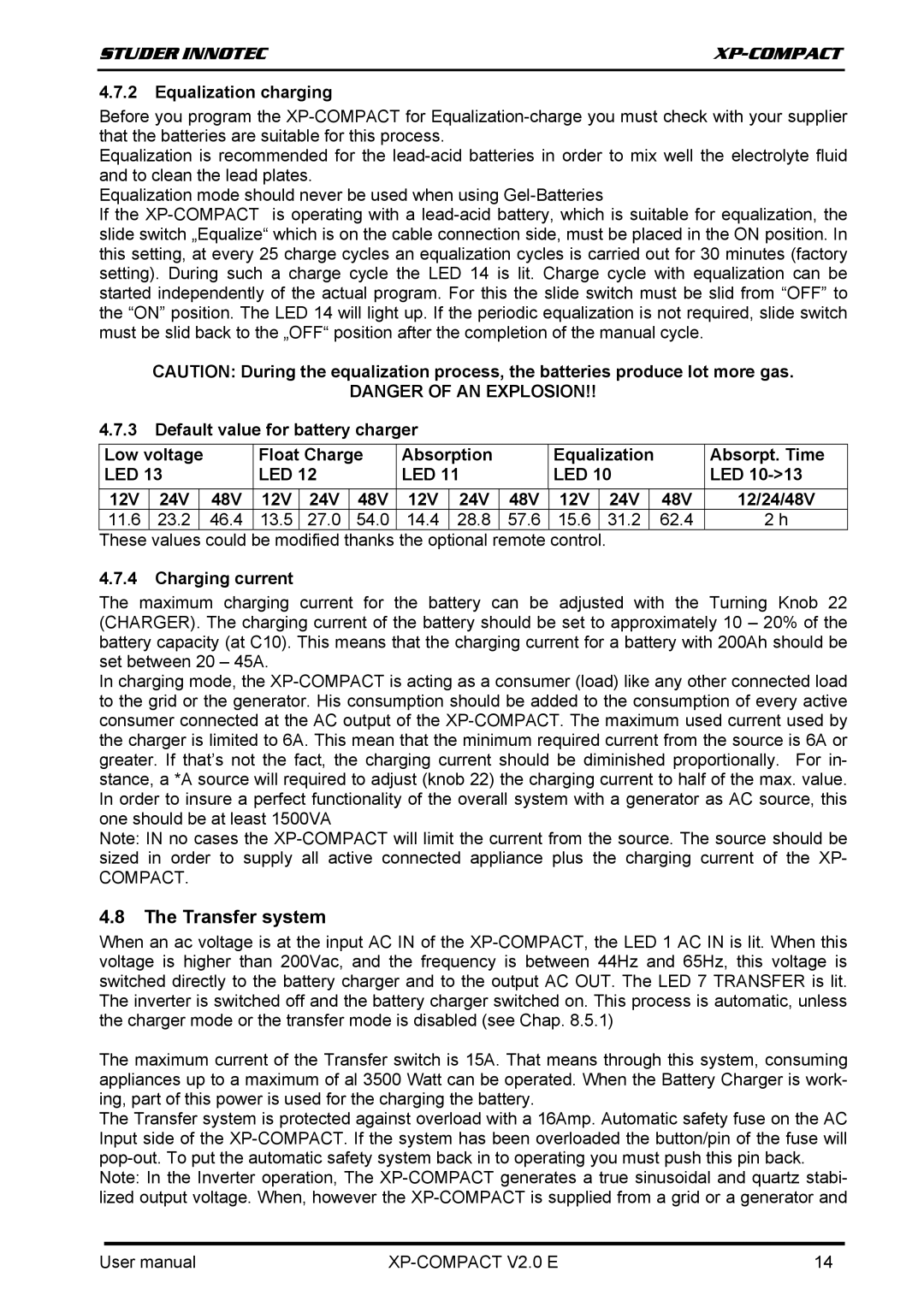4.7.2Equalization charging
Before you program the XP-COMPACT for Equalization-charge you must check with your supplier that the batteries are suitable for this process.
Equalization is recommended for the lead-acid batteries in order to mix well the electrolyte fluid and to clean the lead plates.
Equalization mode should never be used when using Gel-Batteries
If the XP-COMPACT is operating with a lead-acid battery, which is suitable for equalization, the slide switch „Equalize“ which is on the cable connection side, must be placed in the ON position. In this setting, at every 25 charge cycles an equalization cycles is carried out for 30 minutes (factory setting). During such a charge cycle the LED 14 is lit. Charge cycle with equalization can be started independently of the actual program. For this the slide switch must be slid from “OFF” to the “ON” position. The LED 14 will light up. If the periodic equalization is not required, slide switch must be slid back to the „OFF“ position after the completion of the manual cycle.
CAUTION: During the equalization process, the batteries produce lot more gas.
DANGER OF AN EXPLOSION!!
4.7.3Default value for battery charger
Low voltage | | Float Charge | Absorption | | Equalization | | Absorpt. Time |
LED 13 | | LED 12 | | LED 11 | | LED 10 | | LED 10->13 |
| | | | | | | | | | | | | | |
12V | 24V | | 48V | 12V | 24V | 48V | 12V | 24V | 48V | 12V | 24V | | 48V | 12/24/48V |
11.6 | 23.2 | | 46.4 | 13.5 | 27.0 | 54.0 | 14.4 | 28.8 | 57.6 | 15.6 | 31.2 | | 62.4 | 2 h |
These values could be modified thanks the optional remote control.
4.7.4Charging current
The maximum charging current for the battery can be adjusted with the Turning Knob 22 (CHARGER). The charging current of the battery should be set to approximately 10 – 20% of the battery capacity (at C10). This means that the charging current for a battery with 200Ah should be set between 20 – 45A.
In charging mode, the XP-COMPACT is acting as a consumer (load) like any other connected load to the grid or the generator. His consumption should be added to the consumption of every active consumer connected at the AC output of the XP-COMPACT. The maximum used current used by the charger is limited to 6A. This mean that the minimum required current from the source is 6A or greater. If that’s not the fact, the charging current should be diminished proportionally. For in- stance, a *A source will required to adjust (knob 22) the charging current to half of the max. value. In order to insure a perfect functionality of the overall system with a generator as AC source, this one should be at least 1500VA
Note: IN no cases the XP-COMPACT will limit the current from the source. The source should be sized in order to supply all active connected appliance plus the charging current of the XP-
COMPACT.
4.8The Transfer system
When an ac voltage is at the input AC IN of the XP-COMPACT, the LED 1 AC IN is lit. When this voltage is higher than 200Vac, and the frequency is between 44Hz and 65Hz, this voltage is switched directly to the battery charger and to the output AC OUT. The LED 7 TRANSFER is lit. The inverter is switched off and the battery charger switched on. This process is automatic, unless the charger mode or the transfer mode is disabled (see Chap. 8.5.1)
The maximum current of the Transfer switch is 15A. That means through this system, consuming appliances up to a maximum of al 3500 Watt can be operated. When the Battery Charger is work- ing, part of this power is used for the charging the battery.
The Transfer system is protected against overload with a 16Amp. Automatic safety fuse on the AC Input side of the XP-COMPACT. If the system has been overloaded the button/pin of the fuse will pop-out. To put the automatic safety system back in to operating you must push this pin back.
Note: In the Inverter operation, The XP-COMPACT generates a true sinusoidal and quartz stabi- lized output voltage. When, however the XP-COMPACT is supplied from a grid or a generator and
User manual | XP-COMPACT V2.0 E | 14 |
